Leeds Turned Upside Down
Tagged as: free_spaces history imaginary social_struggles wildlifeNeighbourhoods: leeds ls1 ls10 ls11
On Saturday, October 10th 2009 a group of about 45 people gathered at a pub in South Leeds for an event that would take us through some of the forgotten places and forgotten stories of Leeds. During the three-hour stroll we took a critical look outside of the orthodox coding of space and we considered how social relations have shaped - and continue to shape - the skyline of our city.
Click on any photo for a high-resolution version.
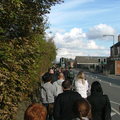
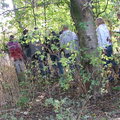
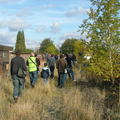
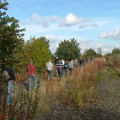
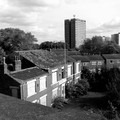
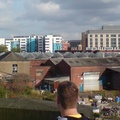
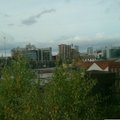
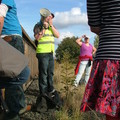
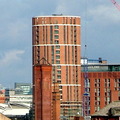
Click on a thumbnail for a slideshow view
This is a summary of the event - the group is going to make a full document of it available soon.
"History is like a train running down a track. There is only one direction (forward) and we move smoothly and punctually from one decade to the next. If we ever turn round and look back, we can see that everything that has happened before has been leading up to this point. We can predict every station along the route. History is Progress with a capital P. It's unstoppable, and there's no getting off.
That is the standard view of economic history, as you might read it from one of Leeds City Council's websites, for example. But it is a view that glosses over all the false starts, collisions, hold-ups, dead-ends and diversions. Things that could have been and things that nearly were are missing. Most of the time it's hard to see the non-linear aspects of history: it really does seem as if this is the only way things could be. All this here is the only Leeds that's possible. That's the immense power of routine, doing the same thing today that we did yesterday and the day befoe that and the day before that. But every now and then, history goes off the rails and everything gets thrown into question. When that happens, we can see that this Leeds is just one of millions of possible Leeds. This city is the outcome of a whole series of struggles and battles and events that could have ended differently.
The global financial meltdown last October was one of those moments when history unfreezes. The economic repercussions are still reverberating through Leeds, as they will do for many years. We can see it in the current bin strike, the talk of closures, the all-round feeling of austerity. We can measure it in redundancies, wage cuts and loss of services. But the political consequences are far more uncertain, and much harder to map."
So began a walk through the psychogeographic landscape of the last 200 years. Over a road, down a ginnel, through some brambles and onto a disused railway embankment, we found ourselves in one of the forgotten in-between places that are left out between the chapters in the story of Progress. This is one of the many spaces that get left behind when the movement of labour and commodities is diverted onto a new branch. Only 30 years ago this was one of the arteries connecting Leeds to the economic body of Britain, but now it is starting to revert to a more natural form. Young ash and silver birch grow in abundance, valerian and willow-herb filling the gaps between old sleepers and ballast. Three different apple trees on the banks provided snacks for the hungry.
Had Leeds economy kept moving as its architects had hoped, this disused railway was to have become a path between a gentrified housing zone, "Holbeck Urban Village" and the offices and consumer play-grounds of the centre. Of course the idea of a village was a lie: the property prices here would have excluded those in low-paid jobs from living here. Another zone of cheaper housing would have been required, further away from the unaffordable centre. But of course this has become the story of a future that never was. When Leeds’ civic architect John Thorpe was asked about the different possibilities for the development of Leeds he replied, “There is no Plan B.” But just as the official history misses out much of what ordinary Loiners did, the neoliberal dream took no account of our desires, our vision, our unrealised potentialities. We are now treading a route that is not shown on ordinary road-maps.
With the autumn sun behind us, we walked towards the centre, like an Emerald City in the distance, perhaps housing a wizard who was not all that he wished to appear. The embankment leads onto a viaduct that in its day was a marvel of engineering, having 85 brick arches. Our height gave us a great view of some of the sites of Leeds' Other History, the parts missed out from the council website.
Armley jail, where Eliza Stafford was imprisoned for a month having been convicted of stealing 2lbs of dripping, provided the backdrop for the story of the Dripping Riots of 1865. The gasometer to the North marked the site of the 1890 gas strike and ensuing riot. To the South we had a good view of the back-to-back housing in Holbeck which was subject of a report to Parliament in 1842, as this new high-density housing for the mill-workers had been worst effected by Cholera. Nearby Holbeck Moor was a site for many political gatherings including Suffragette rallies. In 1936, Oswald Mosley had tried to hold a rally there but was chased away by an overwhelmingly hostile crowd.
Further on we got a fine view of some of the mills that were the engines of the economy of their day. Their owners, who perversely are eulogised in the Leeds City Council version of history, were ruthless masters of a terrorised workforce. John Marshall, whose mills still dominate the area, was a staunch opponent of factory reform. The great victories of his workers were to have the length of their working days reduced from 16 to 12 and then 8 hours. The most important invention to come from these mills was not any new type of loom or engine; it was the invention of the weekend, a hitherto unrecognised right to rest, that was won from the bosses of these places. Chartism and its further social reforms were all played out hereabouts.
Having come as close as we could get to the city centre by this route, the panorama of the skyline tells a story. We listed several of the misconceived high-rise developments, largely unoccupied, which sprang up in the few years before the crash. Much of this development was fuelled not by people's need for housing, but by speculation and a desire to make a profit. There were to have been several new tall buildings, but most of them have been cancelled. The ones that were put up tell a sorry story - Bridgewater Place, aerodynamically designed to be a hazard to passing cyclists, and City ("sh**ty") Island, a cluster of unwanted, overpriced, vacant properties. These follies stand alongside those of a previous era, the Italianate towers of Tower Works; although they were designed to demonstrate the cultivation of their owners, their real purpose was to extract dust from the mills below. Similarly with today's tall buildings, the race to build ever higher was driven by the needs of capital, not of human beings. As with the mills, these were to be machines for the efficient reproduction of capital.
We're asking a lot of questions about the future of Leeds and we don't have all the answers - and nor should we. We want to open up opportunities for people to discuss and re-imagine how they want their city to be. This event was conceived and produced by the Leeds In Crisis group (and in association with The Yorkshire Evening Pest) - please check out the website and come along to one of our meetings. The next thing we're planning is on November 4th - details will be announced on Northern Indymedia soon.
Links:
 Contact email: marker at indymedia dot org
Contact email: marker at indymedia dot org







Leed Turned Upside Down Again
LTUD+2
Leeds was turned upside-down once again on 5th November 2011, as reported at http://www.spaceproject.org.uk/component/content/article/4-news/13-leeds-turned-upside-down.html